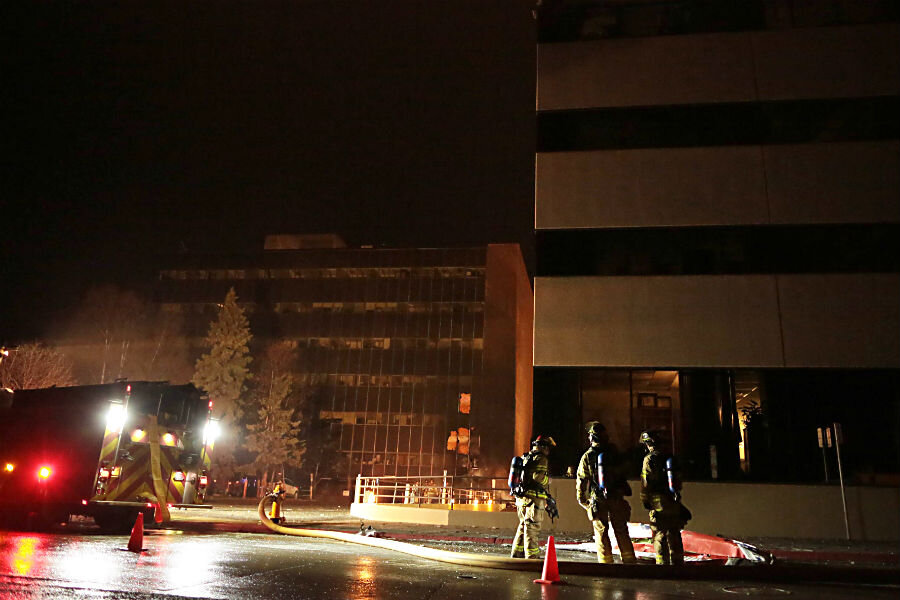Small plane crashes in downtown Anchorage, Alaska, killing one person
Loading...
| Anchorage, Alaska
A small plane clipped a downtown Anchorage office building and then slammed into a nearby commercial building early Tuesday, igniting a fire and killing at least one person aboard, authorities said.
There were no injuries on the ground, but it's unclear if anyone else was in the plane, Anchorage Assistant Fire Chief Alex Boyd said. The crash happened in the heart of downtown, in an area surrounded by office buildings, hotels and other businesses, before most businesses opened for the day.
The aircraft belongs to the Civil Air Patrol, a civilian auxiliary of the U.S. Air Force that is made up of volunteers who help in search and rescue missions, federal authorities said.
There were no sanctioned flights when the plane crashed at 6:18 a.m., said Clint Johnson, Alaska region chief for the National Transportation Safety Board.
Karen Bowen, a bookkeeper who answered the phone at the Civil Air Patrol office, relayed comments from the group's commander that the crash is under investigation. The Associated Press left a message for the volunteer commander, who wasn't in the office.
The plane came in over the shoreline toward downtown and clipped the corner of the office building, where some state employees work. Then it crashed into the lower side of an adjacent multistory commercial building, setting it on fire.
Crews responded quickly and had the blaze under control, fire officials said.
The Anchorage Daily News reported that power to roughly 600 downtown customers “was knocked out due to the fire from the plane crash” for about half an hour, Municipal Light and Power spokeswoman Julie Harris said. All but eight have had power restored since, however, with crews working to bring their power back online.
“The plane that crashed did some damage to our transformer, but the transformer did not actually blow,” Harris said.
Authorities later announced the FBI was joining the investigation. Anchorage-based bureau spokeswoman Staci Feger-Pellessier declined to say why but noted there was no reason to believe the crash was terrorism-related.
Kent Haina, a 747 captain for UPS, said he was taking out his garbage when he saw the plane go down at a shallow angle and disappear behind a building. He then heard a loud thud and saw a plume of black smoke.
Haina said the wind was howling at the time.
"(The engine) didn't sound like it was in trouble, but the weather was pretty windy," he said. "I said to myself, 'It's not good weather to be flying in.'"
"I heard it circling and I knew it was having problems," said Mike Coumbe, who lives a few blocks away, told the Anchorage Daily News. "I heard the plane and tried to see the plane and I heard it hit -- it just stopped."
The NTSB's Johnson said the crash happened amid blustery winds but that the agency is not ruling out anything as a cause. The agency looks at pilot error, mechanical problems and weather.
Vince Maiorano was working as a line cook at Snow City Cafe across the street when he heard the plane strike a transformer. He and a co-worker ran up to the plane to see if anyone was inside, but they didn't see anybody and were driven back by large flames that overtook the aircraft.
"We heard a loud whoosh noise when the transformer went out, and that's when the power went out on the whole block," Maiorano said.
The plane came in over the shoreline toward downtown and clipped the corner of the office building, where some state employees work. Then it crashed into the lower side of an adjacent multistory commercial building, setting it on fire.
Crews responded quickly and had the blaze under control, fire officials said.
The commercial building appeared to be unoccupied at the time of the crash, though crews were searching it to make sure, Don Tallman of the Anchorage Fire Department. Authorities cordoned off an area around the building, closing several roads.
Alaska Gov. Bill Walker was among those checking out the scene Tuesday. Because one of the buildings houses state workers, Walker said he wanted to "find out what's going on."
The Federal Aviation Administration and the NTSB will investigate, FAA spokesman Allen Kenitzer said. He had no additional details on the type of plane.
Karen Bowen, a bookkeeper who answered the phone at the Civil Air Patrol office, relayed comments from the group's commander that the crash is under investigation. The Associated Press left a message for the volunteer commander, who wasn't in the office.
___
Associated Press writers Alina Hartounian and Courtney Bonnell in Phoenix contributed to this report.







